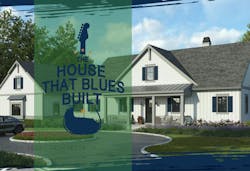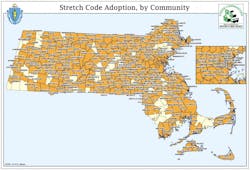Going Green in The House That Blues Built
Energy efficiency and sustainability have been part of good building practices long before they became part of building codes. In Massachusetts, municipalities including Williamstown, a town in the Berkshire Mountains where Albert and Christina Cummings are constructing their personal home, have the option of requiring newly built homes to be held to a higher standard than the basic building energy code: a Stretch Code. The Massachusetts Stretch Code requires newly built homes to follow the performance path of the base energy code for the state and to achieve a HERS (Home Energy Rating System) rating of 55.
“We had to demonstrate that we could meet the Stretch Code before we could get our building permit,” says Albert Cummings. “Every new residential building in our town needs to achieve a HERS rating of 55. We squeaked by and got to 55 before we factored in some of the components we’ll be using to build the house.”
The HERS index is a nationally recognized program developed by the Residential Energy Services Network (RESNET). An inspection and testing by a certified RESNET Home Energy Rater is required for every HERS index rating on a property. That rating is based on both the energy efficiency of the building as well as how much clean energy is generated by the house, such as with solar panels or wind energy. HERS testing includes air leakage and an inspection of the insulation installation.
The baseline HERS rating of 100 reflects the amount of energy used by a newly built home constructed and tested to meet the current standard building code. The lower the HERS rating, the better. Generally, a house that has a HERS rating of 50 will use 50% less energy than a new home built to code and about 80% less energy than a typical resale home.
“There’s a night and day difference in building today compared to a decade ago,” Albert says. "The objective is to achieve super airtightness, but then that requires bringing in equipment for fresh air flow.”
The Stretch Code
In Massachusetts, the Stretch Code is based on performance rather than on specific energy efficiency measures. Builders have flexibility to decide how to design the home to achieve the desired HERS rating and which energy efficient components to install.
“The initial report we got on our house estimated that we would save $9,348 annually on our utility bills,” Albert says. “But the real goals are to use less energy, to reduce our carbon footprint and to benefit the earth, not just to save money.”
However, Cummings isn’t convinced that the Stretch Code is the right way to approach sustainable building.
“The Stretch Code was presented to voters as an environmental benefit that would only increase the cost of building by about $600 or so,” Cummings claims. “But it costs $2,500 to hire an engineer for the analysis and then you have to spend three times the normal amount on insulation. It’s great to use less propane gas to heat your house, but you have to use 10 times the electricity for heat and fans to increase air flow.”
Cummings estimates the Stretch Code adds as much as $75,000 to the cost of building a house in his area, which deters some builders from building there.
Achieving a lower HERS rating
The Cummings consulted with numerous partners for their custom home, including Trane for the HVAC system, DuPont and Owens Corning for insulation, and Titebond for caulk and sealants.
“To lower your HERS rating, you have to work together with your suppliers and contractors to increase your insulation, choose the right windows and make sure you’re building a tight house,” Cummings says. He designed the house first and then had to make changes with the help of the building sponsors to meet the requirements of the Stretch Code.
“We had to have many group conversations to make sure all the products work together to achieve our goals and lower the HERS rating,” he says. “Now we’ve been able to get the estimated HERS rating down to 45.”
The Cummings and their partners will share more details about their collaboration as progress continues on The House That Blues Built.


